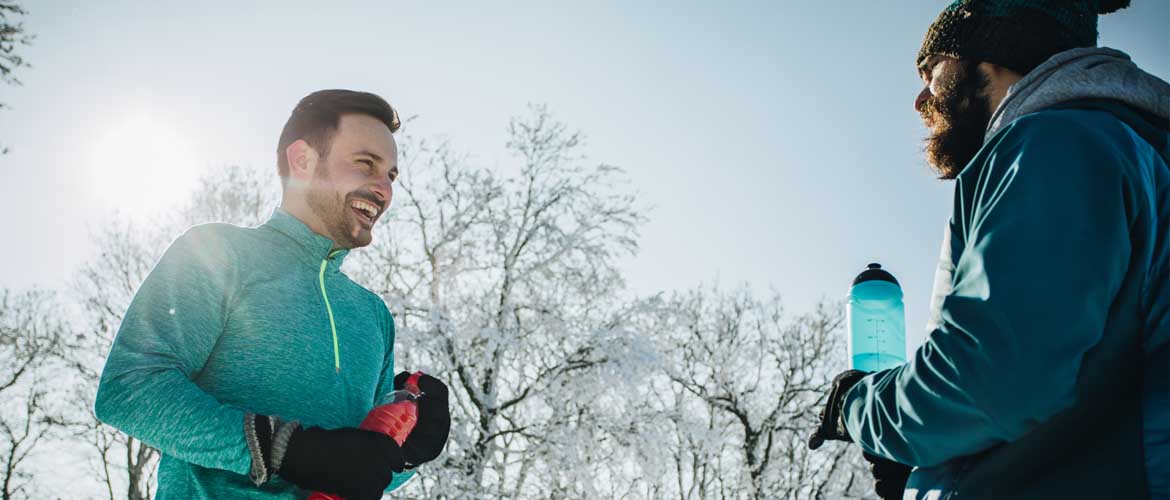February 12, 2018
Before you let Mother Nature stop you in your tracks, here’s everything you need to know about cold-weather workouts.
Types of Outdoor Workouts
While most people may automatically think of running outdoors, there are a variety of other outdoor winter workouts, too. Skiing, ice skating, ice hockey and snowboarding are all fun winter activities and solid workout options during the cold months. Like all sports and recreational activities, these outdoor workouts also require precautionary measures to ensure a safe and effective workout.
If you are planning a run in cold weather, start by mapping out your route. Look for streets and sidewalks that have been plowed or shoveled to avoid trips and falls. Be aware of any remaining slush that may be lingering and schedule your outside workouts during the day, which can help you spot black ice.
MedExpress Pro Tip: Alex Negle, MedExpress employee and avid runner, opts for wearing trail running shoes in slushy conditions, which boast more tread.

What’s So Great About Outdoor Winter Workouts?
If you can motivate yourself to leave your warm home, you’ll reap some great benefits. Not only will you get your daily dose of vitamin D (don’t forget the sunscreen!) and feel energized long after your outdoor workout is done, you’ll actually burn more calories. Your body has to work harder to maintain its core temperature because of the cold temperatures outside.
MedExpress Pro Tip: Having trouble staying motivated? Use the buddy system. “I like to schedule a run with a friend, or even with a local running club, to hold me accountable,” says Negle.
How Cold Is Too Cold to Exercise Outside?
When it comes to working out during the winter, there are a few factors that come into play such as temperature, wind chill, and duration of time you will be outdoors. According to the American Council on Exercise, temperatures of 20 degrees Fahrenheit and above possess little danger, as long as you’re properly dressed in cold weather gear. Once the wind chill, which is the perceived apparent temperature, falls, the risk of frostbite increases. Be mindful that if the wind chill is -18 Fahrenheit, frostbite can occur in less than 30 minutes.
And while it may seem like a summertime concern, you can still become dehydrated in the winter. In colder weather, your body’s thirst response reacts differently, making it easier to become dehydrated. This time of year, you’re less likely to be aware of how much you’re sweating and not realize how much fluid you’re losing. Because of this, hydration often isn’t top of mind for winter athletes. If you’re exercising outside, aim to drink as much water as you would during a summer workout. If you’re going to be active for over an hour or if you’re doing a sport at a higher altitude, add in electrolytes and carbohydrates to refuel.
MedExpress Pro Tip: If possible, try to position the second half of your workout with your back to the wind. If you’ve worked up a sweat, this decreases your chance of becoming cold from the wind exposure.

Know the Warning Signs of Frostbite
Classified as an injury, frostbite is the freezing of your skin and underlying tissues from exposure to cold weather conditions. Frostbite usually occurs in fingers, toes, and feet but can also affect extremities like ears, nose, and cheeks.
Be on the lookout for:
- Blisters
- Numbness
- Blackness
- Tingling and redness
If you notice any of these signs, seek warm shelter immediately. Begin to move the area affected to increase blood flow. While you might think it’s a good idea to rub the area, it may cause tissue damage. Instead, you should place the area affected into warm (not hot) water. If you are ever in doubt over the severity of frostbite symptoms, it's best to seek immediate medical attention.

What Should I Wear During An Outdoor Workout?
Have you ever heard of the saying “failing to prepare is preparing to fail?” When it comes to cold weather clothing, a little preparation can go a long way to keep you safe.
The 3 Key Layers:
- Start with a thin layer of synthetic material to wick away perspiration
- Add a fleece or wool layer for insulation
- Top it off with a breathable, waterproof, and wind-repelling layer
Depending on the intensity of your workout, you may have to experiment with which combination of cold weather gear works best for you. Once you start to move, your body will warm up, so it’s okay to feel cold at first.
And the preparation for outdoor workouts doesn’t stop there. You’ll also want to wear gloves and a hat or helmet, and consider a scarf or a cold weather facemask, too. For winter-proof footwear, wear a shoe size up to accommodate wool or thermal socks.
MedExpress Pro Tip: If your workout involves your hands being on a wet surface (like pushups or burpees), try layering latex gloves under your regular gloves. This will prevent your hands from becoming wet, even if your gloves do.
Jack frost, cold temperatures, and snow don’t need to stop your outdoor physical activity. With a bit of preparation and education, you can keep logging those workouts all season long.
Be sure to talk to your doctor before beginning any new exercise regime.
